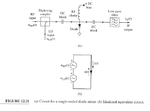kamranraja222
Member level 1
Hello everyone,
My question is "how to find an input impedance of a Multiplier PIN diode?." I am using HSMP-3822 diode to make an X3 multiplier. My input signal is 100 MHz and output is 300 MHz. The input signal power is 10dBm and a bandpass filter is also used at the output port. Thanks and best regards
My question is "how to find an input impedance of a Multiplier PIN diode?." I am using HSMP-3822 diode to make an X3 multiplier. My input signal is 100 MHz and output is 300 MHz. The input signal power is 10dBm and a bandpass filter is also used at the output port. Thanks and best regards
